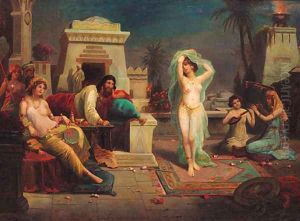Paul-Louis Collin Paintings
Paul-Louis Collin was a French artist known for his paintings, drawings, and printmaking. Born on June 22, 1865, in Luneville, France, Collin demonstrated an early talent for visual arts, which led him to pursue formal artistic training. He studied under Gustave Moreau at the École des Beaux-Arts in Paris, a prestigious institution that produced many significant artists of the era. Collin was a contemporary of Henri Matisse and Georges Rouault, who were also students of Moreau.
Collin's artistic career was marked by his versatility in different mediums, including painting, drawing, and particularly etching. He was part of the etching revival in France, a movement in the late 19th and early 20th centuries that sought to reinvigorate the art of printmaking. His work often depicted landscapes, portraits, and genre scenes. Collin was skilled in capturing the subtleties of light and shadow, which is evident in his etchings and paintings.
During his lifetime, Paul-Louis Collin participated in various exhibitions and received recognition for his contributions to French art. He exhibited his work at the Salon des Artistes Français, where he was awarded a third-class medal in 1890 and a second-class medal in 1904. Collin's work was also shown at the Salon d'Automne, an annual art exhibition aimed at promoting avant-garde artistic movements.
Despite his association with notable figures and participation in important art movements, Collin did not achieve the same level of fame as some of his contemporaries. However, his work has been appreciated for its craftsmanship and the quiet beauty of his etching technique. Paul-Louis Collin passed away in 1943, leaving behind a legacy of refined and evocative artworks that contribute to the rich tapestry of French art history.
